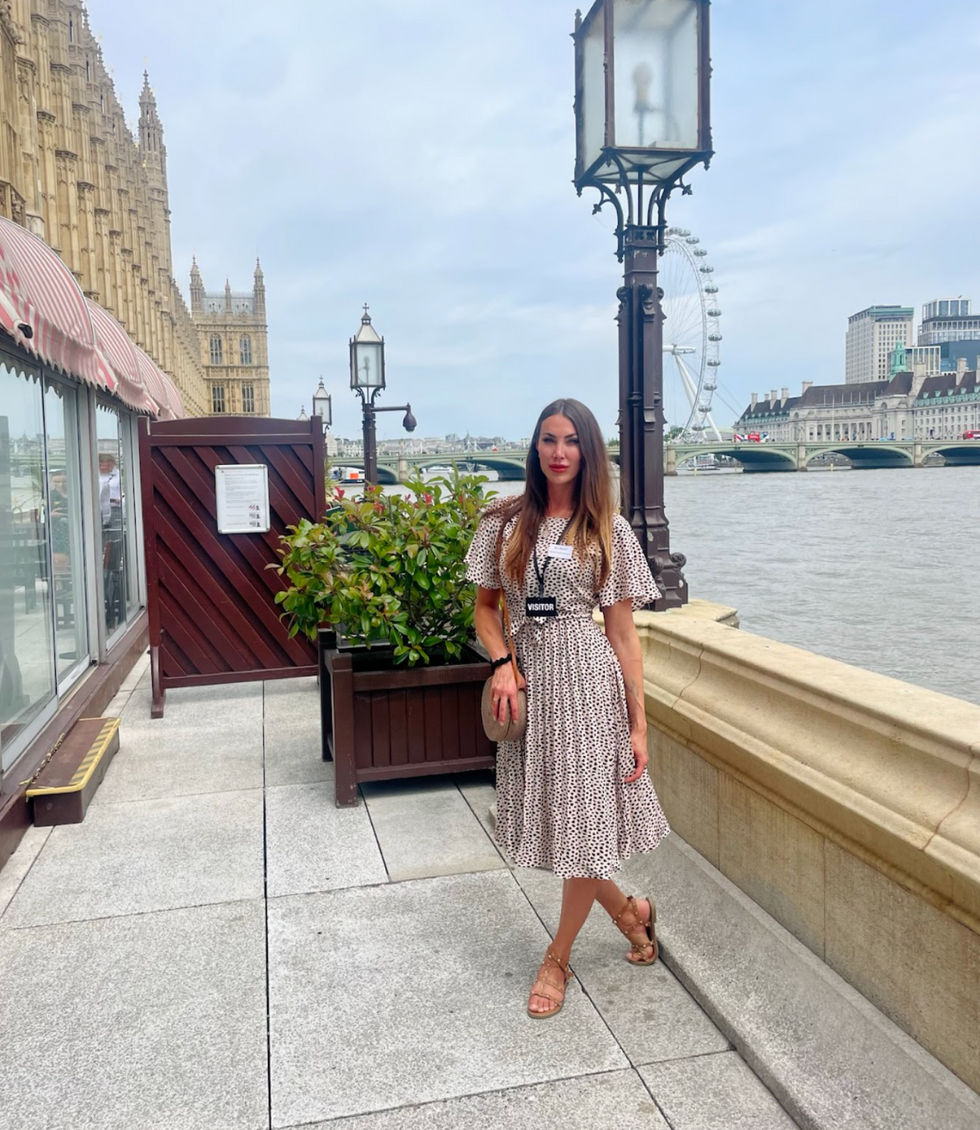As told to Erica Rimlinger
I grew up in the UK, and for most of my teenage years, I couldn’t smile in photos. I was convinced I looked hideous. I covered my mouth when I laughed and turned my face when I felt someone looking too close. When I was 18 years old, I was flipping through Vogue magazine when I read the headline, “How to fix your gummy smile.” Within days I was in the aesthetician’s chair getting lip fillers, and my smile was “gummy” no more.
I loved it. My new lips felt like freedom. I couldn’t stop smiling in photos and wore red lipstick. But I craved more symmetry. Everywhere I looked, I was bombarded by images of perfection: filtered heart-shaped faces with full lips, petite button noses and big round eyes. I started getting fillers in my cheeks, my jawline and chin. Immersed in a culture that held “the golden ratio” to the ideal, I was unable to see the truth — I had an addiction. In reality, the “golden ratio” was unattainable, and my face was a reflection of the distortion in my mind.
Even when the results were bad, even when I regretted the procedure immediately, I couldn’t stop. This is just what women do, right? We can schedule a lunchtime filler as easily as we can buy a new eyeshadow palette. I had mixed experiences: not all the medical aestheticians were great and not all the non-medical aestheticians were terrible. Some were extremely caring and considerate.
I remember being consumed with the way I looked as early as age 5. My parents were image-conscious and looks were highly prized. My parents owned a gym, and my dad was a bodybuilder. My early development was surrounded by mirror gazers checking their muscles. For me, my body dysmorphic disorder (BDD) was both environmental and genetic. My dad spent hours locked in the bathroom removing all his body hair. It would take hours for him to get ready and finally leave the house. Looking back, I realize he showed signs of BDD.
Because my family moved frequently, I changed schools often. My BDD thrived in my efforts to fit in. I incessantly compared myself to other kids and thought I was odd-looking. There was no part of my body too small or insignificant for me to critique. From the way my freckles were arranged on my knee to the way my toe was shaped, every molecule in my body was wrong.
As a teenager, the self-critical voice inside me got louder and nastier. I wouldn’t let people take photos of one side of my face. I refused to get into a swimsuit after I accidentally caught my reflection in a shop window and realized that, like nearly every other woman after puberty, I had cellulite. I covered up and avoided beaches and swimming pools. Boys were interested in dating, but I was too worried that parts of me were deformed. I was always told I was pretty but struggled to believe it. I clutched the compliments like a treasure. People told me I was vain, and without the knowledge I have today, I agreed. The constant mirror-checking and attention to the way I looked had to be vanity, surely.
Then I found alcohol. When I drank, I escaped my inner bully. I self-medicated my anxiety to oblivion — and found myself in dangerous situations. Around this time, the smartphone was invented. I could now take photos of myself, zoom in on them, and really address the inadequacies I saw with filters. It was exhausting.
After alcohol, I found hair extensions, crash diets, and eventually, by my late teens, fillers and surgery.
When my dad passed away, I entered a bodybuilding show, thinking I was honoring him and his career. In reality, bodybuilding was the most toxic environment I could have found. The extreme regimen of exercising, dieting, body-hair control, tanning, fillers and more sated the ravenous appetite of my BDD. On the outside, I appeared powerful and confident. I even won a show. Once again, my environment convinced me everything was fine, and the attention I gave to my looks was rewarded with a trophy.
In addition to leaving permanent scar tissue under my eyes, fillers cost eye-watering amounts of money. After an accident, the plastic surgeon told me I had so much filler in my nose it had weakened the cartilage, necessitating more surgical time removing stubborn filler. I was told that even if I hadn’t had the accident and allowed the filler to dissolve naturally, my nose would never be the same.
I moved down a conveyor belt at these clinics. Since I paid, they were happy to do whatever procedure I requested. There was no screening for BDD. Not long after my nose job, I found myself asking about a full face-lift. I was 32 years old. After the surgeon turned me away, I fell into a deep depression. I thought, “I had this extreme surgery, and I’m still not happy with myself. I can’t live like this. I need to sort this out.” I knew then it was time to seek therapy.
When I learned I had BDD, I vowed to take responsibility rather than let it control me. It wasn’t me. It was a part of me that needed a lot of help and understanding. I stopped drinking, found yoga and became a certified yoga teacher. I started to create a new relationship with my body, one rooted in love and respect.
I sought out BDD support online via the Body Dysmorphic Disorder Foundation and found there were others like me. I began advocating for people with BDD and was invited to speak at the Houses of Parliament for the Health and Social Care Committee to discuss the impact of body image on mental and physical health.
The testimony I gave to the committee was included in legislation to improve regulation of the cosmetic industry in the UK and require labeling on advertising images that use modifications. Image filters are so convincing, the deceptive perfection is harmful to children’s developing self-esteem and contributes to feelings of inadequacy. I also would like to see more robust BDD and mental health screenings required before cosmetic procedures, as well as waiting periods between consultations and treatments.
The legislation has drawn interest from the press, which televised my testimony. Watching videos of myself on BBC Breakfast predictably triggered my BDD. I saw nothing but flaws in my face. These thoughts were so quick I had to stop, label the intruding thoughts and voices as the demons that accompany my BDD, and recognize them as separate from me.
Instead of watching, I turned off the video and listened to the words I spoke in the televised segment. Finally, my BDD voices were quiet. My actual voice, the one our lawmakers heard, was clear and powerful. That’s the voice I want to project — the one I’m starting to grow, develop and trust.
- Get the Facts About Common Cosmetic Procedures: Dermal Fillers ›
- Cosmetic Skin Procedures - HealthyWomen ›
- Face Yoga 101 - HealthyWomen ›







